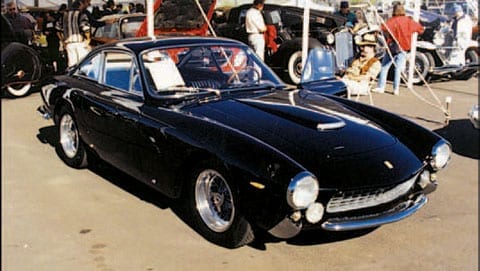The Ferrari market is a fluid animal, with both classic and modern cars moving in and out of favor. Here’s my current read on where the action is.
The flavor of the month is definitely the 250 Lusso. Three years ago, you couldn’t give a Lusso away. Now great Lussos are bringing two and three times as much as Daytonas. For example, Bonhams sold a competition-prepared Lusso, S/N 5367GT, with period TdF history, for $424,362 at Gstaad in December of last year. At the same event, a concours-condition street Lusso, S/N 5303GT, sold for $235,897. The two Daytona coupes that sold brought $93,958 and $102,632.
There’s a reason for this popularity. The Lusso shares the same engine, transmission, brakes and suspension as the “street”-model 250 SWB. Because it is eligible for the many rallies and touring events now so popular in Europe, the Lusso has become the “alternative” to the 250 SWB, without the million-dollar-plus price.
While the Lusso may weigh 100 kilos more than a steel-bodied 250 SWB, it has a superior Watts-link rear suspension, evolved directly from the 250 GTO. Consequently, a well-prepared Lusso is comparable in performance with a steel-bodied 250 SWB on the track. Further, in my eyes the Lusso is more attractive than the 250 SWB.
With the Euro up more than 25% against the dollar during the past few months, it is not surprising that the few Lussos that come on the market in the US are finding their way to the other side of the Atlantic. And as always, while top cars are bringing top prices, the rustbuckets and Bondobarges are still stuck in the Ferrari dog pound, unsellable at nearly any price.
Demand for the 246 GT and GTS continues to be strong. Their timeless styling, comfortable yet race-car-like cockpits, light steering, braking and shifting all combine with an engine that sounds more powerful than it is. Because the 246 series gives a great illusion of performance and speed, it makes every trip to the grocery store seem like a practice session for Le Mans, without the fear of speeding tickets.
The Dino downside is that these cars are now 30-plus years old and are the poster children for deferred maintenance and the need for a detailed mechanical and body inspection as part of the purchase agreement. Simply put, the older the Ferrari, the greater the need for a thorough inspection.
While Dinos haven’t gotten back to the world-record $250,000 paid for one in Monterey during the boom, it’s not surprising to see a very nice GTS with chairs and flares come near the $100,000 mark. Coupes are just not very popular in the US, even if they drive better, and seem to move in the $60,000-$70,000 range, again for superb examples. It appears that Dinos will always be high on the list of Ferrari collectibles, and buying one today, even at full market prices, may seem like a shrewd move in 24 months.
The 456 GT and the 550 Maranello are getting close to bargain-basement pricing. A 1995 456 now sells for as little as $75,000, while 550s can be found for $125,000. Both the 456 and the 550 offer state-of-the-art supercar performance and creature comforts for what is, in the Ferrari world, low pricing, especially when compared with their MSRPs ($207,000 for the 456, $208,000 for the 550).
The downside? No question these cars are close to fully depreciated, but … how close? We thought that TRs were cheap at $65,000, and now look at them. Which brings us to…
The 512 BB at $65,000 and the Testarossa at $50,000 have failed the test of time as collectibles. While they are user-friendly and practical to use on a daily basis, and remain the high performance bargains in the Ferrari world (selling for less than a 246GT or GTS), no one seems to care.
Of course, while the price of entry may be low, both normal and deferred maintenance can make these supercar bargains into money pits, as the cost of an engine may exceed 50% of the value of the car. If you have to have one of these, buy only a perfect car, and sell it before the next major service comes due
The award for chasing the market down seems to go to the dozen or so die-hards who continue to advertise Euro 550 Barchettas at prices up to (and even over) $300,000, or US-spec 550 Barchettas at prices over $300,000.
While the 550 Barchetta may be gorgeous when topless, its impractical and very-hard-to-operate folding top makes it less than user-friendly on anything but a sunny day. Then add in the many US model 550 Barchettas on the market and the many soon-to-finally-be-legalized Euro cars about to become available here (another case of speculators seeing higher prices in the US, but by the time their cars have cleared all the necessary importation hurdles, the market here has begun to sag to near-European levels). The correct market price today for a US Barchetta, in my opinion, is a more modest $275,000, while a Euro car would be hardpressed, once releases were in finally in hand, to bring $245,000.


